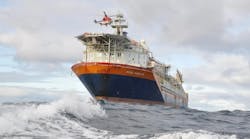Process industry cable rack from Nokia Aluminium.
Independence from telecommunications giant Nokia has left Nokia Aluminium (NA) free to pursue new markets, including the offshore sector. Lightweight aluminum cable racks and ladders will be offered as an alternative to the heavier, galvanized steel versions currently prevalent in the North Sea.
Last December, the company was bought from Nokia by a combination of its existing managers, Morgan Stanley Capital Partners and Finland's CapMan Capital Management. It is an FIM300 million operation with a production plant and headquarters in Pikkala, southern Finland, and a subsidiary in Stockholm.
Over 12,000 tons of accessories are produced annually at Pikkala. NA imports raw materials in the form of ingots and does all its own extrusions. And no production is wasted: all excess aluminium is recycled.
NA makes four rack systems (series 6-9) of different loading capacities for housing power cables. They are manufactured from high-strength profiled aluminium alloys of which alloy 6082 A1 MgSi 1 is certified by Lloyd's and DnV for use in extreme conditions, including offshore.
"Aluminium is excellent for offshore conditions," says NA export manager Kari Kanerva, "being a lightweight, homogeneous and non-corrosive material. Every time you cut galvanized steel you have the same problems: the surface is galvanized, but the interior is not. When you cut, rust starts so you must take preventative action. There is no danger of that happening with aluminium."
This autumn, NA plans to introduce Systemal, a lower cost version of its established rack range, with a maximum achievable span of up to 10 metres. With fewer parts, it should also be easier to install. "That also makes the price lower," says Kanerva.
Another advantage of aluminium for cable racks is its fire resistance qualities. "Working offshore with saws, galvanized aluminium doesn't create sparks which could ignite flammable gases. And with our racks, we can cover cables with aluminium plates to give better fire resistance. Aluminium is also a very durable material: over the years our customers have been able to minimize their costs, even though the initial investment is a little higher than for galvanized steel."
Transportation of galvanized steel cable racks and ladders to offshore sectors in West Africa, the Middle East and South East Asia can also create problems, he claims. Metal parts stored for two to three weeks on a boat can already be rusting by the time they reach their destination, or can suffer corrosion when stored in humid environments. Aluminium is not prone to corrosion, and is also lighter to transport than steel.
Copyright 1995 Offshore. All Rights Reserved.





